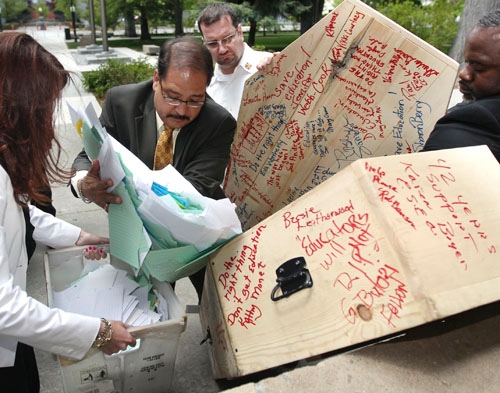Letters to governor focus on ‘death’ of public education


CARSON CITY — A coffin meant to symbolize the demise of public education under Gov. Brian Sandoval’s proposed budget made it as far as the Capitol steps Tuesday before being turned away by police.
Clark County Classroom Education Association President Ruben Murillo did not object to being denied a chance to show Sandoval letters and notes signed by thousands of people upset with his education spending plan.
Mary-Sarah Kinner, the governor’s press secretary, agreed to take the letters inside the Capitol if the coffin were hauled away.
“This is to let the governor know what he is doing to fund education is not in the best interests of Clark County,” said Murillo, who brought the letters and notes from Southern Nevada students, teachers and parents. “If the governor doesn’t hear the people now, he will hear from them at election time.”
But the coffin might have arrived too late because Sandoval and legislative leaders are negotiating a new state budget that probably will not bring much more money to public education.
Because of improving state tax revenue, Sandoval has contended that state education spending had been restored to just shy of 2009 levels. He initially proposed a 9 percent cut.
Also, the Senate late Monday approved an amended version of Senate Bill 229 that removes the “last in, first out” policy of reducing staff during layoff periods.
Now, seniority will be only one of the factors school districts must consider when there is a reduction in force. The teacher’s performance, disciplinary record, criminal history, the difficulty of filling a position and other factors also must be considered.
Murillo said he supports education reforms but thinks they should be subject to collective bargaining negotiations.
“You should have the people most affected at the table,” said Al Martinez, president of Service Employees International Union Local 1107, who helped Murillo carry the coffin. “We are opposed to people telling us how we (should) do collective bargaining.”
Joyce Haldeman, Clark County School District associate superintendent, called SB229, and two related bills, SB225 and SB222, great bills.
“This is a huge step for us,” she said.
SB229 gives beginning teachers three one-year periods on probation before they are dismissed for unsatisfactory performance, instead of the two one-year periods on probation under current laws. Veteran teachers whose performances decline can be placed back on probation, but they will be given targeted training and repeated evaluations to improve before they are dismissed.
“Ninety percent of the teachers are not going to be impacted by this stuff because they are good teachers,” Haldeman said . “If you are a teacher sitting on a campus, knowing there are teachers who are not pulling their weight, you will be pretty glad there is a mechanism to get rid of them.”
Haldeman also said she does not know yet what the effect will be on the Clark County district if legislators agree to reauthorize the $679 million in taxes that expire June 30. The taxes are the linchpin of the negotiations between Sandoval and legislators.
“For every dollar we get back, it will be fewer people laid off,” she said.
Assembly Speaker John Oceguera, D-Las Vegas, said last week that there might be as few as 800 layoffs in Clark County if the expiring taxes continue. Initially, 1,800 layoffs were contemplated in the district.
Under Assembly Bill 117, unanimously approved Monday by the Senate, school districts can cut five non-instructional days a year off their schedules as a way to reduce spending and layoffs.
Initially, the bill called for schools to reduce the year by as many as 10 days, but Senate Majority Leader Steven Horsford, D-Las Vegas, balked at the idea of any instructional days been reduced. Students now attend school 180 days a year.
Contact Capital Bureau Chief Ed Vogel at evogel@reviewjournal.com or 775-687-3901.













